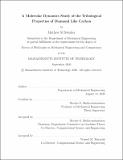| dc.contributor.advisor | Nicolas G. Hadjiconstantinou. | en_US |
| dc.contributor.author | Swisher, Mathew M. | en_US |
| dc.contributor.other | Massachusetts Institute of Technology. Department of Mechanical Engineering. | en_US |
| dc.date.accessioned | 2021-01-05T23:15:14Z | |
| dc.date.available | 2021-01-05T23:15:14Z | |
| dc.date.copyright | 2020 | en_US |
| dc.date.issued | 2020 | en_US |
| dc.identifier.uri | https://hdl.handle.net/1721.1/129046 | |
| dc.description | Thesis: Ph. D., Massachusetts Institute of Technology, Department of Mechanical Engineering, 2020 | en_US |
| dc.description | Cataloged from student-submitted PDF of thesis. | en_US |
| dc.description | Includes bibliographical references (pages 103-111). | en_US |
| dc.description.abstract | Diamond like carbon (DLC) is an attractive choice as a coating for mechanical components, because of its excellent wear resistance and very low coefficient of friction . We use molecular dynamics (MD) simulations with a reactive force field (ReaxFF) to study the friction and wear between DLC counterfaces, both in comparison to and in contact with steel counterfaces. We show that the tribological properties of DLC in dry sliding friction are heavily dependent on both the structure of the DLC as well as the passivation layer that forms on the sliding counterfaces under different environmental conditions, and that when optimizing for the lowest COF the best structure for the DLC depends on the type of passivation layer. We also find that, by preventing bonding across the counterfaces as the thin film of lubricant is squeezed out at the point of contact, the passivation layer is instrumental in the material's ability to resist scuffing and wear. Additionally, we find that the strength and hardness of DLC makes damaging the passivation layer due to contact forces unlikely under real world conditions. Finally, we use MD simulations to study in more detail the transition from lubricated to dry friction, and in particular, the role of DLC surface chemistry and the resulting passivation layer in this transition. Our work shows that the frictional force can be described quite accurately across the transition from pure slip ( dry friction) to the purely hydrodynamic regime using a simple model which superposes the two effects, provided it also accounts for any immobile fluid layers at the fluid-solid interface. We show that, for water lubrication, the transition from the pure slip to the purely hydrodynamic regime occurs at smaller lengthscales in DLC counterfaces compared with steel. | en_US |
| dc.description.statementofresponsibility | by Matthew M. Swisher. | en_US |
| dc.format.extent | 111 pages | en_US |
| dc.language.iso | eng | en_US |
| dc.publisher | Massachusetts Institute of Technology | en_US |
| dc.rights | MIT theses may be protected by copyright. Please reuse MIT thesis content according to the MIT Libraries Permissions Policy, which is available through the URL provided. | en_US |
| dc.rights.uri | http://dspace.mit.edu/handle/1721.1/7582 | en_US |
| dc.subject | Mechanical Engineering. | en_US |
| dc.title | A molecular dynamics study of the tribological properties of diamond like carbon | en_US |
| dc.type | Thesis | en_US |
| dc.description.degree | Ph. D. | en_US |
| dc.contributor.department | Massachusetts Institute of Technology. Department of Mechanical Engineering | en_US |
| dc.identifier.oclc | 1227042771 | en_US |
| dc.description.collection | Ph.D. Massachusetts Institute of Technology, Department of Mechanical Engineering | en_US |
| dspace.imported | 2021-01-05T23:15:10Z | en_US |
| mit.thesis.degree | Doctoral | en_US |
| mit.thesis.department | MechE | en_US |
